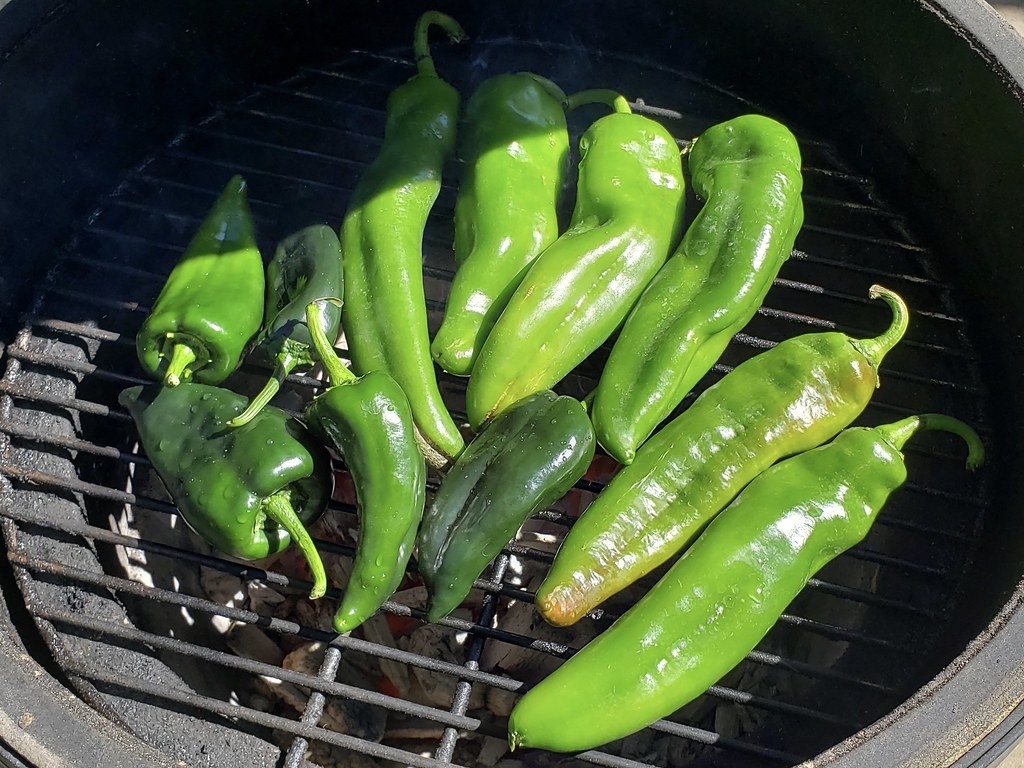Chiles and fire
The sound and smell of charring chiles is a big part of the Colorado farmers market experience in September. The roar of propane burners and rattle of crisped peppers. The sweet, smokey, aroma of burned chile skins and roasted fruit. It's an end-of-summer ritual.
I've bought many a bag of charred chiles at the market, but these days I prefer to buy them fresh and take them home to give them the personal touch over a hot charcoal fire. In my experience, a gently charred chile that is not tumbled is much easier to peel. The blistered skins come off in big pieces and there's no need to rinse them or peel them under water, which would dilute their sublime flavor.
Yesterday I brought home a bag of green poblano (when red ripe and dried, this is known as ancho) and Big Jim chiles, 10 of each. The Big Jim is a New Mexico chile hybrid developed at New Mexico State University. It's the largest of this kind of chile and has a thick skin. Poblanos have a much thinner skin. It would not be a good idea to roast these together in a cage using propane burners: the tender poblanos would be destroyed. It's easy to do them together on a grill.

Short, wide poblanos and long Big Jims on the grill
A week ago, I gave a bunch of Pueblo chiles the same treatment. The Pueblo chile looks a lot like a New Mexico chile, but is quite different. It's a large Mirasol chile that develops pointing up towards the sun. It seems to be a relatively recent import from Mexico. The New Mexico chile points down towards the earth and is derived from chiles grown by Pueblo people of Southwest North America. The Hatch chile is a New Mexico chile grown in the Hatch Valley along the Rio Grande River upstream of Las Cruces, New Mexico. Hatch is a distinguished appellation like Champagne or Napa are for grapes and wine and Palisade is for peaches, and is way ahead of the game in comparison to Colorado's Pueblo chile growers. New Mexico also has an official State Question: "Red or green?" In other words: do you want red chile or green chile on that? Colorado's climate is cooler and red chiles are less often found at market. I love all of these chiles, green or red.

I could move to New Mexico just for the plates
It doesn't take long over a hot fire for big blisters to form on the Big Jims and smaller ones to form on the poblanos. The technique is basic: turn them until the blistering is fairly uniform and then put them, whole, in a dry, heavy pot with a lid to steam for a few minutes. This will let the skins continue to loosen as the chiles cool.

Flipped chiles
Here are the skinned chiles. The poblanos took about twice as long to peel because the thinner skins come off in smaller pieces. I don't sweat the little scraps of charred skin and never rinse the chiles. You wouldn't rinse a steak or a sausage, would you?

Big Jim chiles, skinned

Poblano chiles
The final steps are trimming the stems, scraping the seeds from the inside, and putting them in freezer containers with the juices on the plates and in the pot. I will use the Big Jims in fall and winter stews and use the poblanos as a condiment with tacos or eggs or grilled steak.